In 1972, The Hoi Polloi, Inc. company began publishing a tarot deck that was unlike any other up to that point. It wasn’t a deck that emulated an older art style or tried to look like it was out of the 1500s. It embraced the study in contradiction that defined the ’70s aesthetic: a balance of drab earth tones and campy colors, nature-loving hippiedom and high-tech futurism, austerity and decadence. Its contemporary harvest golds and neon pinks colored Pamela Coleman Smith’s ‘medieval’ universe, and it threw Victorian Gothic lettering into moddish title lozenges. And then, unlike any tarot producer up to that point, Hoi Polloi marketed their mishmash deck as a game instead of a divination tool and put it in department stores all over the country alongside Old Maid and Uno cards. Their deck was poised to become the classic tarot deck in the American cultural subconscious.
But instead, Hoi Polloi’s deck, The Tarot, sold well through the mid 1980s in three different packaging variations, and then it entirely disappeared. Today, little is known about why the deck was created, who created it, or why it quietly exited the marketplace. Other popular decks of the early 1970s, like U.S. Games’s The Rider Tarot and Frankie Albano’s The Albano-Waite Tarot, have remained staple decks in Tarot culture. Others, like University Books deck and the bootlegs of it printed by Merrimack Publishing and B. Shackman faded from production as the companies were bought or folded, but they still remained a discussed and valued part of tarot history. But the Hoi Polloi deck went the way of avocado colored kitchen appliances and pink toilets: a collective fad barely to be remembered and never to be repeated.

I think that the rise and fall of the Hoi Polloi deck has a lot to do with one man in particular: Bob Reiss. A 1956 Harvard MBA graduate and Brooklyn native, Reiss had remained in New York and had gone on to found a toy and game company, Reiss Games. Reiss, however, was not in the position of a larger game company like Parker Brother or Hasbro that was looking to build a catalog of easy-to-play ‘classic’ games that could be produced for decades. Reiss was an entrepreneur, and he was looking to capitalize on what was popular at the moment before moving on to the next big thing. Looking at some of the games in Reiss’s catalogue, the company did maintain a list perennial staples like basic playing cards, checkers and chess sets, and backgammon, but their focus was a rotation of titles that tapped into the day’s zeitgeist for a year or two, then were retired in favor of something new. As the nation was becoming frustrated with the Vietnam War and Watergate, Reiss published games like The Next President and Lie, Steal, and Cheat: The Game of Political Power. As excitement was building toward the bicentennial, for example, Reiss released a game called 1776: The Birth of a Nation. When second wave feminism was at its peak, they published He-She-Him-Her, a game where women seek to escape the kitchen and men do all they can to keep them there.
During his time as a game producer, Bob Reiss went on to have a couple excellent examples of product development and execution that became classic case studies for Harvard Business School. What the focus of these studies are is how Reiss was able to successfully diversify risk when it came to creating and selling his game products.
I think that part of his risk diversification strategy in the early 1970s was creating multiple small companies, and I believe that Hoi Polloi, Inc. was one of these.
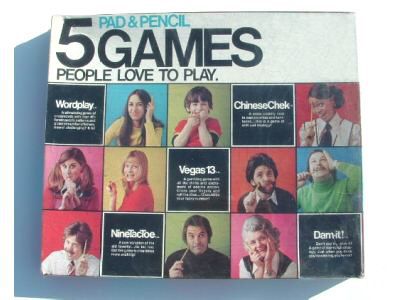
If you look up what some of Hoi Polloi, Inc.’s products were, you’ll find a list of fairly disposable games, the type you might pick up in Dollar Stores. Most of their titles were games you could play with a pad of paper, like tic-tac-toe, Chinese checkers, or sort of Mad Libs type games. A lot of these ended up packaged together in an omnibus title 5 Pad & Pencil Games People Love to Play. Hoi Polloi did have a few card decks and other games in its catalogue, but anything more involved than these were always released in conjunction with Reiss Associates as the marketer.
This could be just a familiar partnership, but I think that Hoi Polloi was largely just a bit of a shell company for Bob Reiss. I think it was a division that could produce steady income from cheap products without diluting the brand of the parent company. It was also a handy outlet to insulate the main company from potential failures of more risky ventures, such as that misogynistic He-She-Him-Her game previously mentioned, which was a partnership between Hoi Polloi and Reiss.
What I think is perhaps the most telling bit of evidence that Hoi Polloi was essentially just a shell of Reiss is the fact that they were both headquartered in the same building in New York City. The company address of Hoi Polloi, Inc. was never listed on the packaging of any of their Tarot decks, but on other Hoi Polloi products it was given as 1150 Broadway, New York, NY 10001. (Not coincidentally, this is also the address given for Romany Merchandise Corp. on the back of the 1980s Tarot package.) Reiss’s address was listed at 230 Fifth Avenue, New York, NY 10001. Drop these listings into Google Maps, and it is very obvious that the companies were in each other’s pockets.
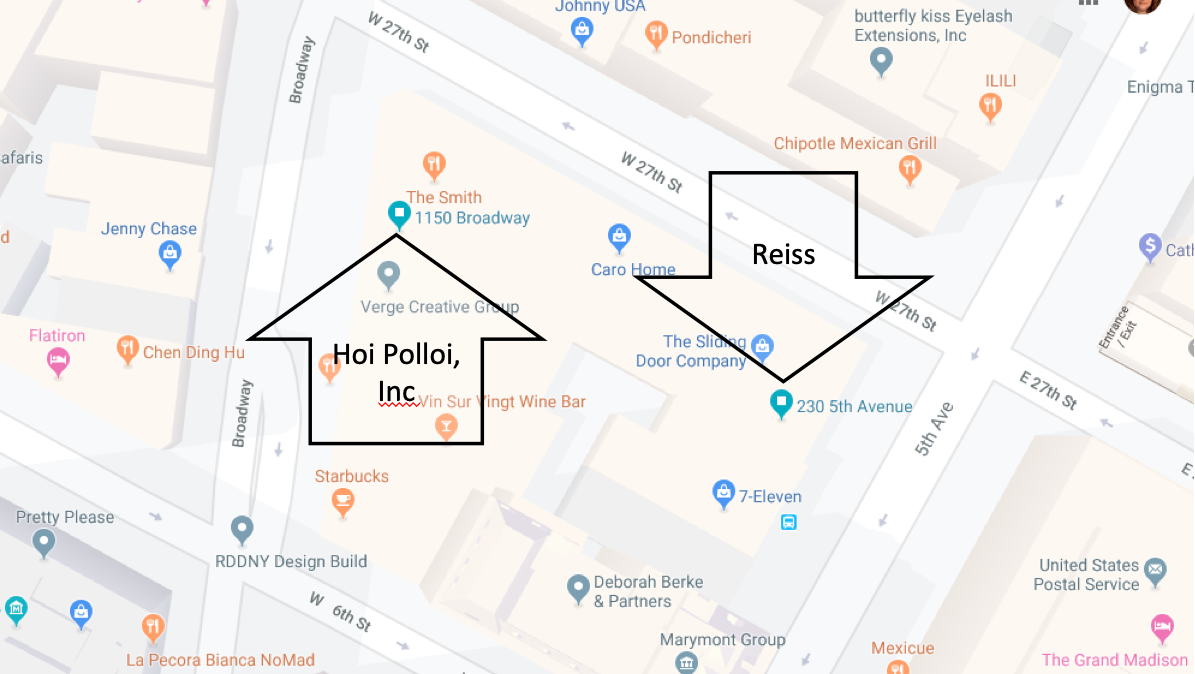
Now, with at least a couple companies based on riding the waves of public interest, Reiss couldn’t leave the rising swell of magic and the occult unexplored. The occult was a major player of American pop culture in the late ’60s through early ’80s. The film Rosemary’s Baby had been released in 1968, and The Exorcist was later released in 1973. Scores of other less enduring works were published in literature, television, and film during this era. The time was definitely right for a little game company to make some money off of magic. After all, some of Reiss’s larger competitors like Parker Brothers — who acquired the rights to Ouija in 1966 — were profitably riding this particular gravy train.
Again diversifying his risk, Reiss used his primary company to release a quality line of stage magic tricks more palatable to the general public. These were sold nationwide in the then most dominant department stores: Sears and J.C. Penny. To tap into the riskier occult vein, Reiss relied on Hoi Polloi to push two cheaper products in more common stores: an astrology kit and a tarot deck.

Now, Reiss was a pretty savvy fellow. In order to further minimize risk to Hoi Polloi and Reiss with these releases, he needed to downgrade the demonic aspect many people in the 1970s assumed these things to have. He also had to find ways to make these products fit his company. After all, neither Reiss Associates nor Hoi Polloi was an esoterica publishing house: they were board game companies. All of Reiss’s connections and distributors were pushing entertainment, not enlightenment.
Reiss needed to gamify the Hoi Polloi Tarot.
So someone — maybe even Reiss himself — picked up a Rider Waite deck (likely a University Books deck, given its New York City ubiquity at the time), grabbed an in-house graphic artist (likely Jason Peterson, the designer credited on a couple versions of the box), and set the kid to trace out the figures on the cards and simplify their designs. Then they had the designer make the cards look a lot like Hoi Polloi’s other board games with lots of bright colors and high contrast between lots of black and white elements. With the cards looking less like something one would find in a gypsy caravan and more like a cool new game, Hoi Polloi developed an instruction booklet that not only included divinatory meanings and a few spreads, but all sorts of suggestions on the tons of fun games that could play with the cards and how they could even be used for poker and bridge if you only removed the major arcana and the pages. For maybe two weeks of work and a minimal cash outlay, Hoi Polloi and Reiss Games had a solid product they could move to market.
They did so quickly in 1972, with packaging that resembled a wooden box. Likely judging that to be too esoteric and alienating, they changed the packaging to resemble a more traditional board game in 1973. This long, skinny purple box had bright, eye-catching contrasting colors, and it sold very well. It was a bit ridiculous to package cards like this, though, and it was very easy to damage the cards in the box, so by the early 1980s, the packaging was changed to resemble that used for Uno or Skip-Bo cards.
But the Hoi Polloi Tarot did not survive for too many years after its final packaging design. By the middle of the 1980s, the decks disappeared from the market.
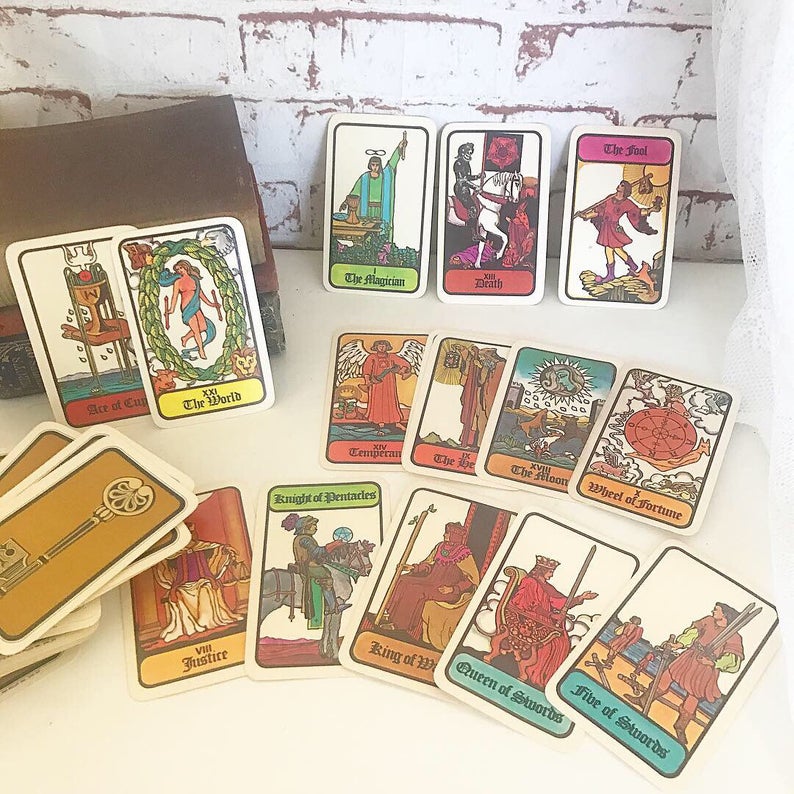
Again, I think Bob Reiss’s business acumen resulted in the death of this deck.
The game industry began to change fairly profoundly in the late 1970s, thanks to the popularity of Star Wars and the rise of home video consoles like the Atari Video Computer system, both of which were released in 1977. Between the public’s interest in buying franchise-branded items and the growing fascination with video games, it became more difficult to move more traditional games, and it would require a much larger financial outlay to produce branded items or to develop expensive video games. Around this time, Bob Reiss sold Reiss Games and Reiss Associates to the National Paragon Corporation and exited his companies. Packaging on items was then changed to reflect that Reiss Associates was now a subsidiary of National Paragon Corporation. In 1981, the company name was officially changed to Paragon-Reiss.
After divesting himself of Reiss Associates, Bob Reiss went on to found a new game company, R&R, and he did have one last major game hurrah through that company. In 1984, Bob Reiss had noted how crazy Americans had become for Trivial Pursuit, which had been released in 1981. He approached TV Guide with the idea of creating a similar trivia game for them, and they immediately contracted him. The timing was perfect as the Trivial Pursuit craze peaked in 1984, and Reiss had his new game out just in time for the 1984 holiday season. With a development cost of just $50,000, Reiss netted $7.5 million in profit, or nearly $20 million in 2019 dollars. Noting both the declining nature of the board game industry and the truism that lighting rarely strikes twice, Reiss sold R&R, took his money, and went on to live comfortably. He did well with all the other businesses he later founded, including a watch company, and today enjoys a semi-retired life in Florida.
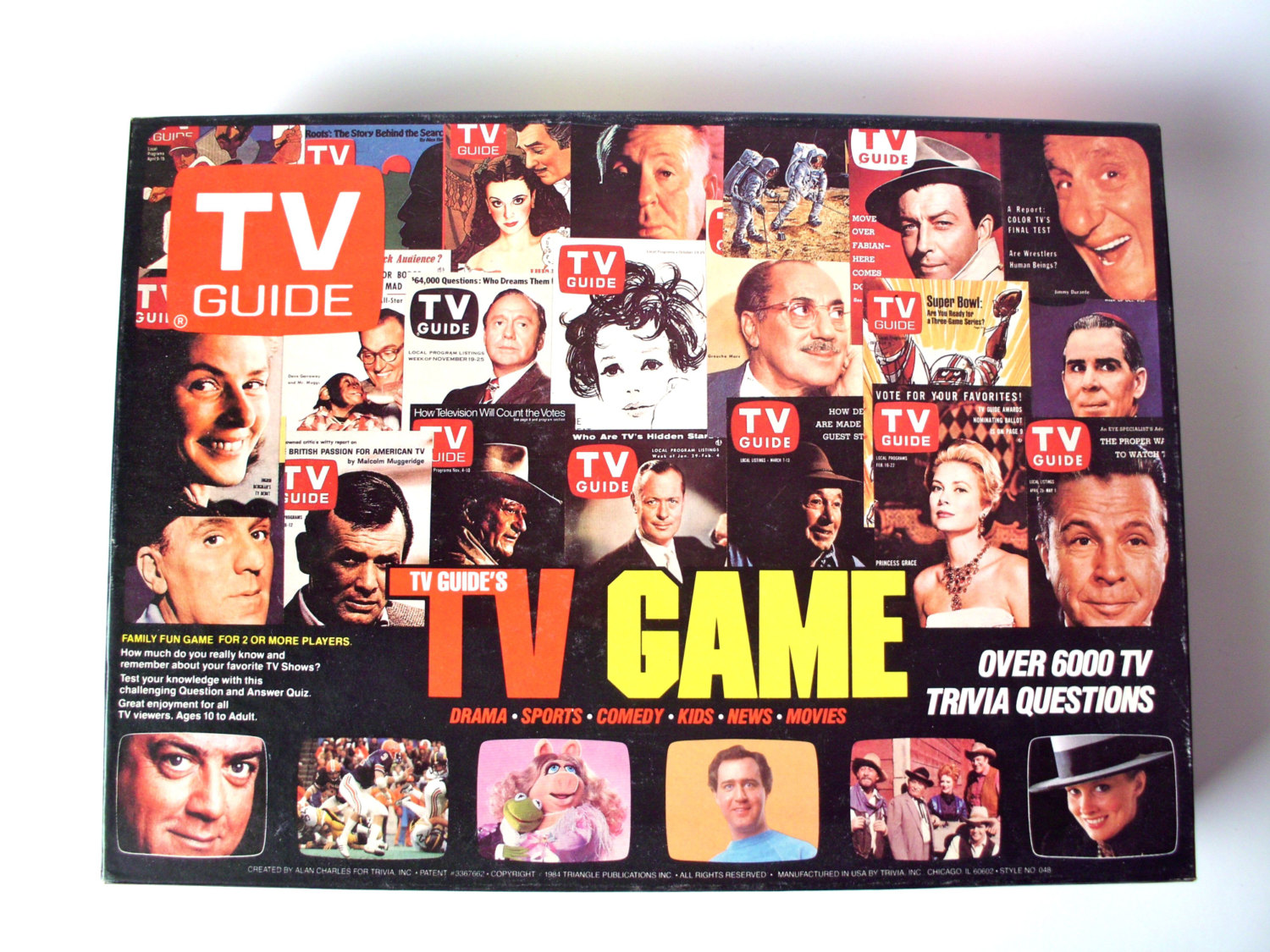
Alas, without Bob Reiss’s entrepreneurship to float them along, Hoi Polloi’s days were numbered. The National Paragon Corporation ultimately proved to have little understanding of the game industry. Paragon-Reiss eventually folded and the National Paragon Corporation transformed itself into a company that made crafting kits for hobby stores. When that industry slowed down, they rebranded themselves as the National Media Corporation and spent much of the 1990s producing infomercials. They’d gone bankrupt by the late 1990s, but they managed to reinvent themselves again thanks to a $30 million cash infusion from an investor, Stephen Lehman. Lehman moved the company out to Los Angeles with the idea of tying their existing infomercial infrastructure to the developing dot com industry, and by 1999, National Media Corporation was directly behind the new site Everything4Less.com. The site was shortly lived, and National Media Corporation went permanently defunct with the dot com crash of the early aughts.
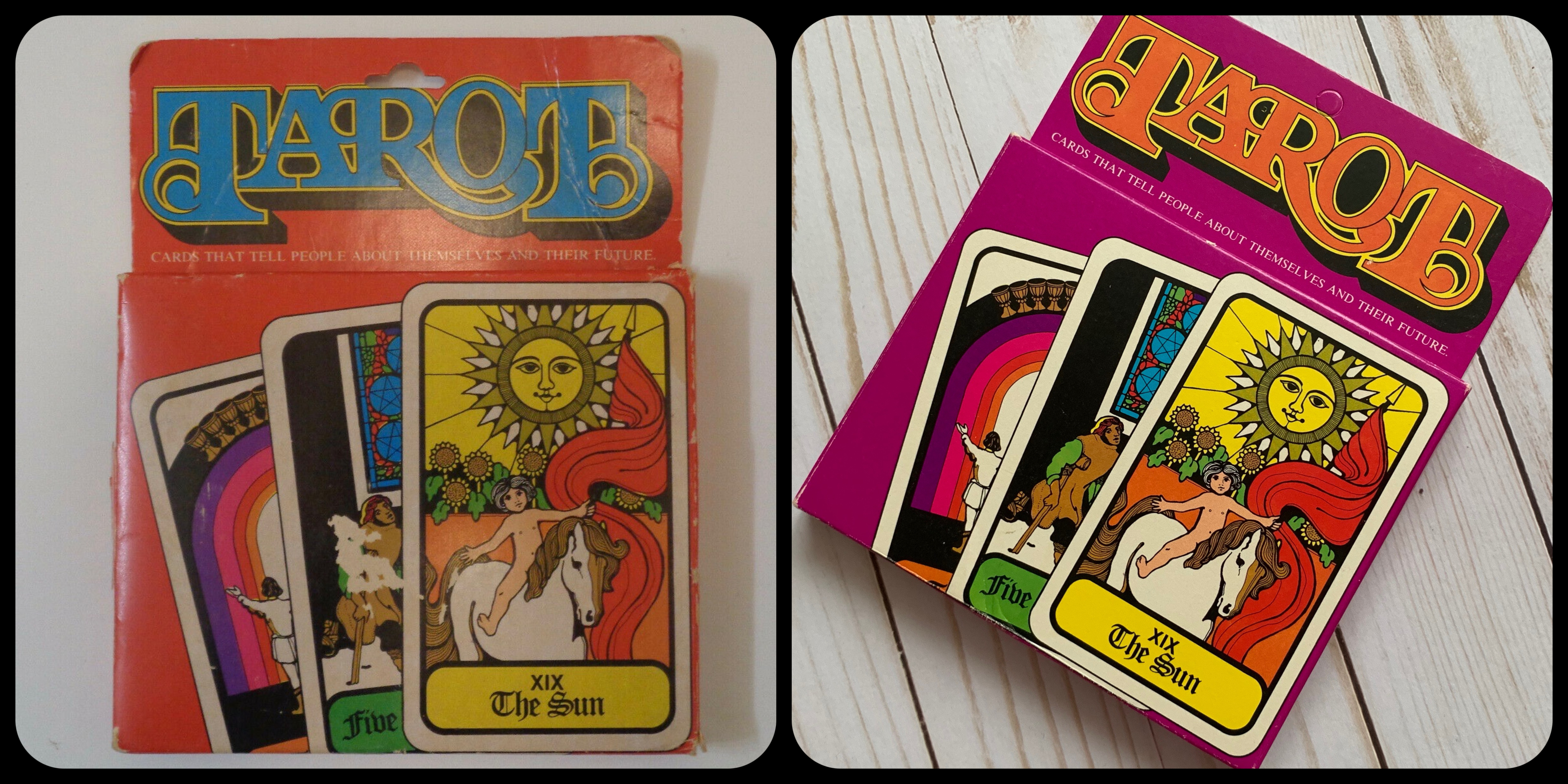
After Paragon-Reiss was created in 1981, they continued sell the Hoi Polloi briefly, but shortly thereafter publication returned to Hoi Polloi, or at least the company they rebranded as in 1973: the Romany Merchandise Corp., still at 1150 Broadway. Romany made a go of continuing to produce and market the products they had developed throughout its existence alongside Reiss. Unfortunately, they produced cheap products that could now be made even more cheaply by others thanks to Nixon’s opening of China. Their products also looked increasingly dated as the more futuristic aesthetic of the 1980s progressed. That combined with the growing decline in public interest for amusements that weren’t related to a franchise or to video games meant that the company could not move enough product to remain profitable. By the late 1980s, Romany were effectively dissolved and ceased production of all items, though their articles of incorporation remain active to this day. Existing stock of their items were farmed out to various liquidation publishers, and the Hoi Polloi ended its run being sold boxless, with a tiny booklet stating it was now distributed by Bell Publishing, itself a division of Crown Publishers.
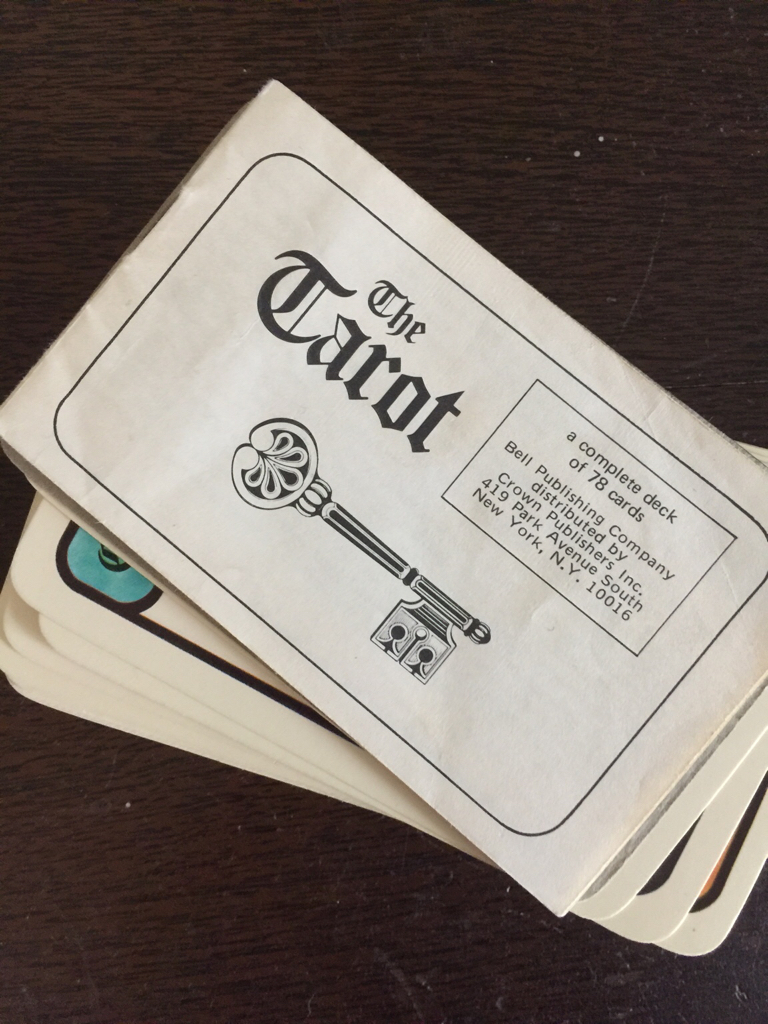
With the rise of Internet auction sites like eBay, the Hoi Polloi Tarot has remained a desirable and sought after deck clear through today, and it can command prices as high as $150 for particularly good decks, though around $100 is more common for decks with boxes and $60 for decks without them. No one has ever attempted to have the Hoi Polloi reissued, though, likely out of the complexity of figuring out just who holds the publication rights to the deck now and the potential threat of US Games suing for copyright infringement. (One would assume that the illustrator, Jason Peterson holds the rights…but I’ve not been able to confirm that.) US Games will lose a lot of its ability to sue in 2021, however, so maybe a Hoi Polloi revival will be on the horizon soon.
Wow, love this deck i had mine when it first came out and i still have it today. I’ve always wondered about the history behind the Hoi Polloi Tarot a fascinating story thank you,
This is fascinating! I have my mom’s Hoi Polloi deck from the 70s. I love the colors but always kind of disliked they paired down the symbolism so much. Though still a neat deck!